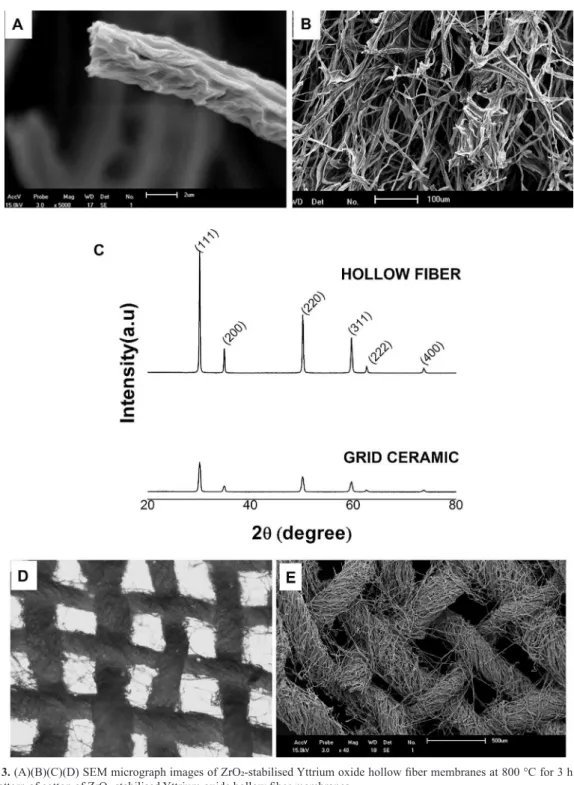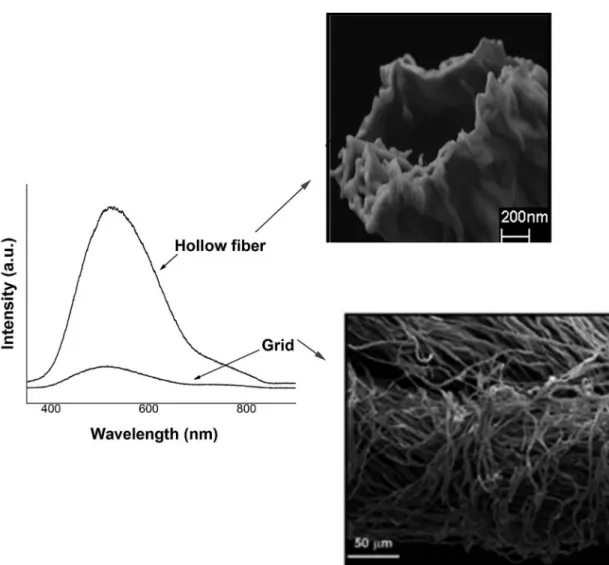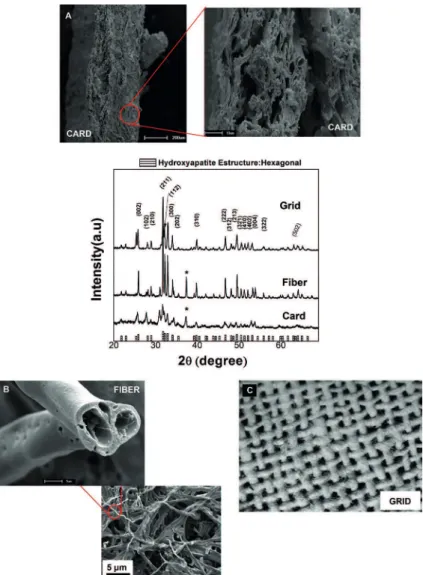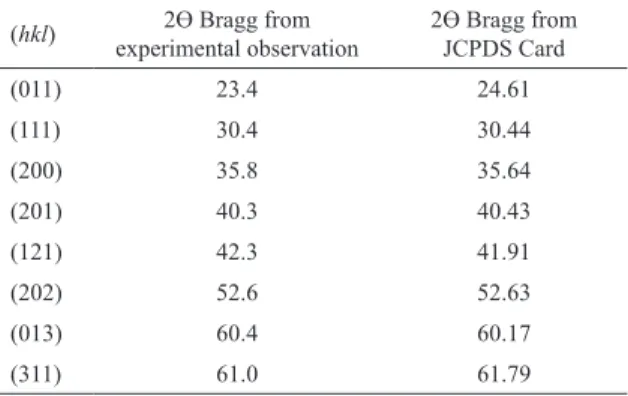Nano and Micro Ceramic Membranes from Degradable Templates
Neftalí Lenin Villarreal Carreñoa*, Cristiane Wienke Raubach Rattmana, Margarete Regina
Freitas Gonçalvesa, Ricardo Marques e Silvaa, Gian Francesco dos Reis Paganottoa, José Carlos
Bernedo Alcazara, Cesar Oropesa Avellanedaa, Ananda Morais Barbosaa, Viviane Coelho Duartea,
Poty Rodrigues de Lucenab
Received: October 2, 2015; Revised: May 17, 2016; Accepted: July 8, 2016
The nano/microstructures with highly porous surface area have attracted tremendous attention, particularly the synthesis and tailoring of porous and hollow materials of high performance. In this paper, an easy method of cost-efective synthesis of hollow ceramic iber membranes based on Hydroxyapatite, TiO2 and ZrO2 stabilized with Yttrium, is proposed by a single chemical route (polymeric precursor method) and a bio-template route (easy to degrade in thermal conditions). This article reports also the ZrTiO4 nanowires synthesis on a silicon (100) wafer in a single step deposition/ thermal treatment. Template-directed membrane synthesis strategy was associated to the polymeric precursor route and spin-coating deposition technique. In this method, ZrTiO4 nanowire ceramic were synthesized by spin-coating thermal treatment technique using polycarbonate membrane as a template. According to the results, after heat-treatment by the template removal, the ZrTiO4 nanowire consists of uniformly deposited crystalline and porous nanoparticles that exhibited a higher surface area and a higher porosity. The polycrystalline nanowires were obtained at by thermal treatment with diameter in the range of 60-100 nm. Photoluminescence spectra were collected for iber at room temperature. These characterizations demonstrate the morphology of structures formed, showing its hollow and porous conformation, suitable applications to advanced reinforced or device component material.
Keywords: Hollow iber ceramic, porous material, photoluminescence and Nanowire
* e-mail: neftali@ufpel.edu.br
1. Introduction
The biotemplating is a new concept to fabricate ceramic materials with novel hierarchical and complex microstructures using natural materials as templates1, posterior conversion of its tissue to ceramic materials has attracted considerable interest due to the possibility of development and optimization of tailoring porous of this materials, which have been made by modiication of raw material, appropriated selection of many diferent species templates, chemical compositions and other physical-chemical conditions to lead to desired materials, retaining the micro-morphologies of their original counterparts. The design of materials tailored porosity exhibit special properties and features that usually cannot be achieved by their conventional dense analogous. Additionally, porous materials ind many applications as inal products and in several technological processes. Macroporous materials are used in various forms and compositions in routinely day, including for instance polymeric foams for packaging, aluminum light-weight structures in buildings and airplanes, as well as porous ceramics for water puriication. The
applications of porous ceramics material have appeared in the last decades, especially for environments where high temperature, extensive wear and corrosive media are involved. Such applications include, for example, the high-temperature thermal insulation, support for catalytic process, and iltration of hot corrosive gases in several industrial processes2,3.
Membrane template-based synthesis of oxide nanostructures can be carried out by illing the porous surface of various polymeric or oxide membrane substrates with precursor solutions4-7, such as cellulose acetate, polycarbonate (PC), PVDF, PTFE and anodized alumina oxide (AAO) nano membranes8. AAO and PC membranes are conveniently used for the growth of nanostructures from various chemical and/or physical synthesis strategies9-11. The diameter and length of the nanostructures obtained can be controlled by the pore size and thickness of the template membrane, but the elimination of the membrane is dependent of certain experimental conditions. Although oxide nanostructures have been grown applying chemical methods, the experimental conditions have strongly limited the compositions to monometallic oxides such as ZnO, SnO2, In2O3 or TiO212.
aGraduated Program Science and Material Engineering, Technology Development Center – CDTEc, Federal University of Pelotas – UFPEL, Pelotas, RS, Brazil
of mono, bi and multimetallic oxides. The experimental simplicity and reproducibility of the methods, combined with the stoichiometric rigor in the synthesis of metal oxide compositions, especially in oxides comprising two or more metals, have increased their ield of application to the synthesis of ferroelectric solid-solutions, photoluminescent powders, magnetic materials, superconductors, nanoparticles and photovoltaic materials. In this synthesis strategy, metallic cations linked to ester chains can be easily obtained through a condensation reaction under acid catalysis conditions13.
In this paper, the authors show an alternative method approach of organic templates method to obtain iber hollow membranes by iniltrated process. This iniltration is performed by the use of a polymeric resin. Also in this study, bimetallic oxide nanowires were prepared using a template- directed method that combines the polymeric precursor method modiied with a spin coating technique. Cellulose Nitrate membrane, cotton iber, carton and natural sponge were used as a degradable template to obtain Hydroxyapatite, TiO2 and ZrO2. Further proceeding from PC membrane were used to synthesis ZrTiO4 nanowire oxide (ZT-nw) integrated into a silicon substrate. The aim of this article is to display a method and chemical route for the preparation of nano and micro ceramic materials.
2. Method and Procedure
2.1. Chemical Synthesis of ceramic iber
membranes at diferent compositions
Firstly, the resins were obtained from metallic cations (Ca, Ti or Zr) by a polymeric precursor method (Pechini method). This method is based on the chelation of cations (metals) by citric acid (CA), in a water solution containing metallic citrate. Chemical process consists of the formation of a M–citrate complex (M = Metallic: Ca, Ti or Zr), followed by a polymerization step with the addition of ethylene glycol (EG) to the metal/citrate solution, at a mass ratio of 40:60 in relation to the citric acid14.
2.2. Route to synthesis of Hydroxyapatite ibers
Calcium nitrate and ammonium phosphate dibasic purchased from Synth were mixed at 80 °C to complete
two hours at 800 °C in air atmosphere, as illustrated in lowchart Figure 1.
2.3. Route to synthesis of TiO
2ibers
The precursor resin used to synthesize TiO2 was obtained by addition of citric acid to titanium isopropoxide (Across) in proportion of 3:1. Distilled water was added to the mixture and the reagents were dissolved by heating (150 °C) and stirring. Later, EG (Aldrich) was added to the solution. A CA/metal ratio of 3:1 (mol) was used. The viscosity of the resin varied between 3.0-5.0 Mpa.
The ceramic ibers were obtained by the calcination process at diferent treatment temperature, such as 600 °C, 800 °C, and 1000 °C at room atmosphere.
2.4. Route to synthesis of ZrO
2ibers stabilized
with Ytrium
Zirconium dichloride (Aldrich) and yttrium oxide (Aldrich) were used for the synthesis of ZrO2 ibers stabilized with Yttrium, (0.9 mol of Zr and 0.1 mol of Y). The metallic citrated was prepared at 70 °C to complete homogenization and stirred with CA, to posterior addition of EG. This was followed by the liquid iniltration of the ibers on the biotemplate. The iniltration was carried out by dropping the precursor resin on the biotemplateby single capillary process; in this method thin strings of cotton, carton, piece of cloth of cotton and natural sponge were employed to prepare the hollow ceramic iber membrane. The template impregnated with the resin was treated at 90 °C for 24 h in an air atmosphere, with posterior annealing treatment at temperatures of 800 °C and 1000 °C in air atmosphere for 3 h. The result is a hollow iber material containing several sizes as functions of biotemplate matrix and thermal treatment15.
2.5. Route to synthesis of ZrTiO
4nanowire
ceramic
Figure 1. Schematic illustration of sample preparation of Zirconium titanate (ZrTiO4) and Hydroxyapatite iber ceramic.
get the precursor complex, the stoichiometric solutions of Ti and Zr were mixed to obtain the polymeric precursor ZrTiO4. The polymeric precursor was then coated onto polycarbonate membranes substrates adapted with millex ilter syringe millipore at a spin rate of 7000 rpm for 20 s, using commercial spinner (Chemat Technology) model KW-4A, illustrated in Figure 1. The millex ilter syringe Millipore was used in order to remove the excess of polymeric precursor solution. The silicon substrate was cleaned with 4:1 v/v H2SO4:H2O2 solution. After coating the membrane, polycarbonate were put onto silicon substrate and exposed to a heat treatment at 350 °C for 2 h in EDG model 3000.
The thermal treatment of the impregnated PC membrane attached to the silicon substrate was performed in an electric oven under air atmosphere at a heating rate of 5 °C/min in two temperature steps: the irst at 350 °C for two hours for the organic matter pyrolysis, and the second at 700 °C for two hours to obtain the nanowire oxide structure. A ZrTiO4 powder sample was obtained with the same precursor solution under identical thermal treatment conditions for crystalline phase comparison16.
2.6. Characterization
The structural analysis of the hollow ceramic iber membranes was carried out by the X-ray difraction (XRD) patterns of the samples, that were obtained using a X-ray powder difractometer (XRD-6000, Shimadzu, Japan) 30 kV and 20 mA, using CuKα radiation (l = 1.5418 Å) with 2q angle scanning from 20-80°, with steps of 0.5°, operating at room temperature. The structure and morphology of the samples was studied by Scanning Electron Microscopy (SEM; Shimadzu, model SSX-550) equipped with X-ray energy dispersive spectroscopy (EDS) and Transmission Electron Microscopy (TEM; Philips, model CM200, operated at 200 kV). Speciic surface area of the nanocomposites was determined by an Autosorb-1C analyzer (Quantachrome Instruments). Energy Dispersive
X-ray Fluorescence Spectrometer (EDX, 720, Shimadzu) determined the chemical concentration of all tin samples, after heat treatment. Photoluminescence spectra were collected for ibers at room temperature by Thermal Jarrel-Ash Monospec 27 monochromator with the nominal output power of the laser kept at 350 mW.
The ceramic ibers were characterized by Field Emission Gun Scanning Electron Microscopy (FESEM), and EDS was performed for direct morphological and microstructural characterization of the sample with a silver electrical contact connected to the aluminum microscope support.
3. Result and Discussion
The SEM images and crystal structure of the ceramic membranes and the respective patterns are presented in Figure 2. The X-ray difraction pattern of TiO2 membranes as a function of the annealing temperature is illustrated in Figure 2b. In this pattern the peaks can be ascribed to the tetragonal rutile phase of crystalline TiO2. The tetragonal rutile phase was formed during the annealing of TiO2 samples in temperatures between 600 and 800 °C, however, the complete formation of rutile phase just was observed at sample using high temperature above 800°C. These observations corroborate with literature for titania powder, rutile transformation takes place at around 780 °C, material derived of sol-gel process17.
Figure 2. (A)(C)(D) SEM micrograph image of TiO2 membrane at 600 °C and (B) XRD pattern of TiO2 at diferent heat treatment (600 °C), (800 °C) and (1000 °C).
it suggest that several parameters (precursor and thermal treatment) can monitored and manipulated in order to control of inal crystalline microstructure, thermogravimetry studies are in progress. Table 1, display the N2 adsorption/desorption isotherms study, where a signiicant change of speciic surface area and porous morphology were observed on YSZ membrane, after annealing samples at 1000 oC, grid YSZ membrane display mesoporous surface, thus the comparative surface analysis could be suggest that porous surface on membranes sample are dependence of original biodegradable template, additionally the role of template was observed in the preliminary study of PL at room temperature of samples illustrated in Figures 4a-b shows the photoluminescence
(PL) at room temperature of the iber and grid membrane annealed at 1000 oC respectively (grid and iber membranes show high crystalline phase). There experimental studies showing that cannot be observed PL emission of materials having high crystallization, but in this case, the presence of morphological structures hollow (here observed just for mesoporous material) proile in a sample may be responsible for signiicant emission photoluminescence14.
Figure 3. (A)(B)(C)(D) SEM micrograph images of ZrO2-stabilised Yttrium oxide hollow iber membranes at 800 °C for 3 h and (C) XRD pattern of cotton of ZrO2-stabilised Yttrium oxide hollow iber membranes.
Table 1: Sample characterization by N2 adsorption annealing at 1000oC for 3h.
Template anneling at 1000oC SBET (m2/g) V p (cm
-3/g-1) d
poreBJH (Å) d Average pore (Å)
Characterization of porous
Cotton iber YSZ 9.94 0.008 31.55 79.73 Behavior of
Mesoporous
Cotton grid YSZ 120.40 0.097 22.66 51.02 Microporous
Figure 4. Photoluminescence at room temperature (λexc = 350.7 nm) of samples of iber and grid ceramic at heat-treatment at 1000 °C for 3 h.
hydroxyapatite obtained from the organic template card when compared with the other shapes (hollow ibers and grid), fact related to the iniltration process (resin precursor) and subsequent burning organic template. The same material can be processed at the lowest scale through the appropriate organic templates (see Figure 6a). Hydroxyapatite illers have known their applications illustrated here by the functionalization with the Agar (a natural polymeric). A transparent polymeric composite is illustrated in Figures 6b-c, which responded as a potential reinforced material. The iber incorporation (0.5-2.0% by weight) into Agar polymer matrix increased signiicantly more than 25% the tensile strain of the pure material. There are reports of a 35% increase in Young’s modulus (elastic modulus) and 25% in tensile strength by the addition of HA nanoparticles in the polymeric matrix19.
Concerning the ZT-nws samples, after membrane deposition and thermal treatment steps, the silicon substrate maintained the characteristic shiny finish of the polished surface with minimal tone variation, indicating
Figure 5. XRD and SEM images of (A) Card, (B) Fiber cotton, (C) Grid shape template of hydroxyapatite at 600 °C for 3 h.
Figure 6. SEM images of hydroxyapatite iber embedded in polymeric matrix.
Figure 7c and 7d shows the FESEM images of the ZT-nws, where one can observed that ZrTiO4 nanowires were formed with a reasonable level of organization, producing high density regions of ZT-nws. Nanowires diameter (d) and length (l) were measured in electron microscopy images by
Figure 7. DRX patterns of (a) ZrTiO4 nanowires on substrate; (b) ZrTiO4 powder obtained from thermal treatment at 700 °C; (c) and (d) shows the FESEM images of the ZrTiO4 nanowires.
(311) 61.0 61.79
The membrane template-assisted methods require good wettability between the precursor solution and the templates to ensure complete illing of the membrane pores. If the precursor solution has good wettability with the template membrane, the capillary forces drive the solution into the pores20. Polycarbonate membranes start to soften at approximately 150 °C and melt at around 240 °C. The low thermal template stability could restrain the oxide nanostructure growth during annealing of the precursor solution due to the destruction of the porous structure of the template. By using the membrane-assisted polymeric precursor route this event was avoided due to the formation of a characteristic glassy organic precursor at temperatures below 200 °C, which anchors the oxide structure inside the pores before the collapse of the porous membrane. In addition, the smooth surface of the silicon substrate contributed signiicantly to maintaining the pore structure during the thermal treatment and to
5. Acknowledgment
The authors gratefully acknowledge the inancial support of CNPq, process 482251/2013-1, CAPES and FAPERGS, process PQG 2013 002049-2551/13-2-1.
6. References
1. Azad AM. Fabrication of yttria-stabilized zirconia nanoibers by electrospinning. MaterialsLetters. 2006;60(1):67-72. DOI: 10.1016/j.matlet.2005.07.085.
2. Greil P. Advanced Engineering Ceramics. Advanced Materials. 2002;14(10):709-716. DOI: 10.1002/1521-4095(20020517).
3. Studart AR, Gonzenbach UT, Tervoort E, Gauckler LJ. Processing routes to macroporous ceramics: A review. Journal of the
American Ceramic Society. 2006;89(6):1771-1789. DOI:
10.1111/j.1551-2916.2006.01044.x.
4. Tabata Y. Biomaterial technology for tissue engineering applications. Journal of the Royal Society Interface. 2009;6(Suppl 3):S311-S324. DOI: 10.1098/rsif.2008.0448.
5. Choi YC, Kim J, Bu SD. Template-directed formation of functional complex metal-oxide nanostructures by combination of sol–gel processing and spin coating. Materials Scienceand Engineering: B. 2006;133(1-3):245-249. DOI: 10.1016/j.mseb.2006.06.034.
6. Hulteen JC, Martin CR. A general template-based method for the preparation of nanomaterials. Journal of Materials Chemistry. 1997;7:1075-1087. DOI: 10.1039/A700027H.
7. Martin CR. Nanomaterials: A Membrane-Based Synthetic Approach. Science. 1994;266 (5193):1961-1966. DOI: 10.1126/ science.266.5193.1961.
8. Watanabe H, Kunitake T. Spatial Disposition of Dye Molecules within Metal Oxide Nanotubes. Chemistry of Materials. 2008;20(15):4998-5004. DOI:10.1021/cm800549n.
9. Chung YA, Lee CY, Peng CW, Chiu HT. Reactive template assisted growth of one-dimensional nanostructures of titanium dioxide. Materials Chemistry and Physics. 2006;100:(2-3):380-384. DOI:10.1016/j.matchemphys.2006.01.018.
10. Hua Z, Yang P, Huang H, Wan J, Yu ZZ, Yang S, et al. Sol–gel template synthesis and characterization of magnetoelectric CoFe2O4/ Pb(Zr0.52Ti0.48)O3 nanotubes. Materials Chemistry and Physics. 2008;107(2):541-546. DOI: 10.1016/j.matchemphys.2007.08.023.
11 Kim J, Yang SA, Choi YC, Han JK, Jeong KO, Yun YJ, et al. Ferroelectricity in Highly Ordered Arrays of Ultra-Thin-Walled Pb(Zr,Ti)O3 Nanotubes Composed of Nanometer-Sized Perovskite Crystallites. Nano Letters. 2008;8(7):1813-1818. DOI:10.1021/nl080240t.
12. Vakifahmetoglu C. Fabrication and properties of ceramic 1D nanostructures from preceramic polymers: a review. Advances in Applied Ceramics: Structural, Functional and Bioceramics. 2011;110(4):188-204. DOI: 10.1179/1743676111Y.0000000007.
13. Lucena PR, Pessoa-Neto OD, Santos IMG, SouzaAG, Longo E, VarelaJA. Synthesis by the polymeric precursor method and characterization of undoped and Sn, Cr and V-doped ZrTiO4.
Journal of Alloys and Compounds. 2005;397(1-2):255-259. doi:10.1016/j.jallcom.2004.11.070.
14. Raubach CW, Krolow MZ, Mesko MF, Cava S, Moreira ML, Longo E, et al. Interfacial photoluminescence emission properties of core/shell Al2O3/ZrO2. CrystEngComm. 2012;14(2):393-396. DOI:10.1039/C1CE06099F.
15. Smith RM, Zhou XD, Huebner W, Anderson HU. Novel yttrium-stabilized zirconia polymeric precursor for the fabrication of thin ilms. Journal of Materials Research. 2004;19(9):2708-2713. DOI: http://dx.doi.org/10.1557/JMR.2004.0352.
16. Lucena PR, Prado WA, Braga VS, Carreño NLV. ZrTiO4 nanowire
growth using membrane-assisted Pechini route. The Electronic Journal of Chemistry. 2014;6(Suppl.1):QI-03. DOI: 10.17807/orbital.v6iS.1.655.
17. Hanaor DAH, Sorrell CC. Review of the anatase to rutile phase transformation. Journal of Materials Science. 2011;46(4):855-874. http://dx.doi.org/10.1007/s10853-010-5113-0.
18. Yang D, Qi L, Ma J. Hierarchically ordered networks comprising crystalline ZrO2 tubes through sol–gel mineralization of eggshell membranes. Journal of Materials Chemistry. 2003; 13(1):1119-1123. DOI: 10.1039/b301077e.
19. Buczynska J, Pamula E, Blazewicz S. Mechanical properties of (poly (L-lactide-co-glycolide))-based ibers coated with hydroxyapatite layer. Journal of Applied Polymer Science. 2011;121(6):3702-3709. DOI: 10.1002/app.34189.
20. Cao G, Liu D. Template-based synthesis of nanorod, nanowire, and nanotube arrays. Advances in Colloid and Interface Science. 2008;136(1-2):45-64. DOI: 10.1016/j.cis.2007.07.003.




